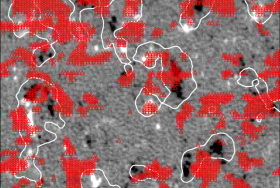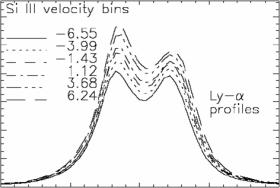First view at the genuine Lyman-α profile
The hydrogen Lyman-α line outshines all other emission lines. It is the prime vehicle for radiative energy transport in the solar atmosphere. Blinded by its brightness, the  SUMER instrument did not dare to look at it. Now, after 12 years of its operation, the SUMER team found a trick to observe it with 'twinkling eyes'. Such high-resolution observations - not hampered by geocoronal absorption - have never been completed before and produced a surprising new result.
SUMER instrument did not dare to look at it. Now, after 12 years of its operation, the SUMER team found a trick to observe it with 'twinkling eyes'. Such high-resolution observations - not hampered by geocoronal absorption - have never been completed before and produced a surprising new result.
Different from most other emission lines, which are symmetric and have a Gaussian shape, Lyman lines are self-reversed because of  opacity effects. As an unexpected result, we found that the strongly self-reversed spectral line profile of Lyman-α is asymmetric so that the peak on the blue side of the central reversal is stronger, oppositely to all the other self-reversed lines of the Lyman series. This has been used to study:
opacity effects. As an unexpected result, we found that the strongly self-reversed spectral line profile of Lyman-α is asymmetric so that the peak on the blue side of the central reversal is stronger, oppositely to all the other self-reversed lines of the Lyman series. This has been used to study:


Our results show that the magnetically structured atmosphere plays a dominating role in the line profile formation and indicates the presence of a persistent downflow at the footpoints of closed loops. We claim that this is the manifestation of a fundamental mass transport process, which Foukal way back in 1978 introduced as 'coronal convection'.
Bibliography:
Curdt et al., A&A 491, L13; 2008
Curdt et al., A&A 492, L9; 2008
Dammasch et al., AnGeo 26, 2959; 2008
Marsch et al., ApJ 685, 1262; 2008
Tian et al., A&A 504, 239; 2009
Tian et al., ApJ 703, L152; 2009
Tian et al., ApJ 704, 883; 2009
